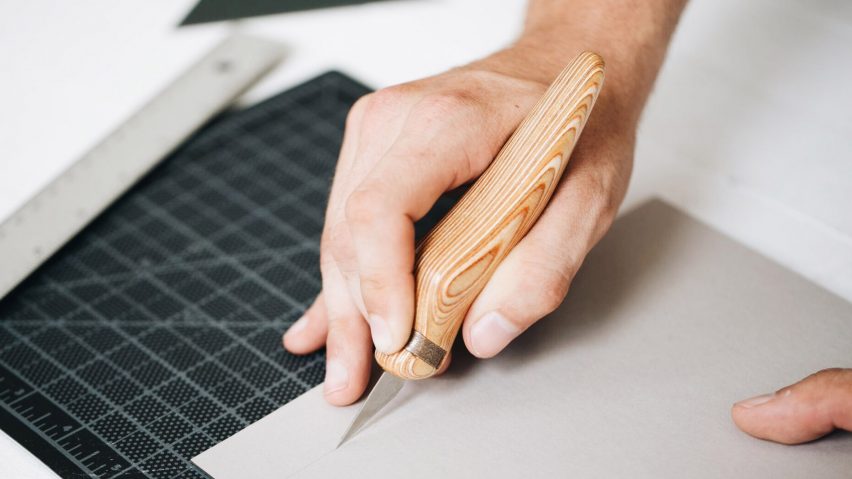Architecture graduate Sean Riley has designed a curvy cutting knife to spare architects from the hand cramps, bruising and sore knuckles endured while making models.
Described by Riley as the "perfect extension" of the hand, the ErgoKiwi tool features a dip on the underside for the thumb to slot into, and a curved top that provides a resting spot for the forefinger.
Riley came up with the curvilinear design while studying at Boston Architectural College, where he found that standard cutting knifes – which typically have hard, cylindrical handles – caused bruises and strain when used for model-making over long periods.
He also noticed that many of his peers were altering their implements with extra cushioning like electrical tape.
"My studio required immense amounts of study models that had to be made by hand," Riley told Dezeen. "After spending hundreds of hours using pen knives and having some of the worst hand cramps, I started thinking about how I could improve work flow."
"I started designing a handle that tackled the biggest problem: hyper-extending knuckle joints, that's where the most pain was coming from," he continued. "Prolonged pressure on a single joint becomes unbearable, so that was where I started."
The Boston-based graduate spent two years developing hundreds of versions of a handle, testing each with designers and architects, and then refining to create a product that is "as simple and easy to use as possible".
He shaped the design first in foam, and then employed digital 3D-modelling tools to quickly create different versions in wood. He eventually developed a handle that is bilaterally symmetrical, so it can be used by both left- and right-handed people.
First launched with a Kickstarter campaign in 2016, the knife is now available with either a white plastic injection-moulded handle, or a variety of woods shaped using a computer numerically controlled (CNC) cutting machine.
"My first choice [was] plywood because after it's cut, it reveals contours, which reminded me of the site models that I would make in architecture school," said Riley.
"The other handles vary in density, weight and grain patterns, which offer unique attributes," he continued. "Bocote has a very beautiful and unique grain pattern; padauk is light weight, making it easy to work with for hours on end; and paperstone is balanced and precise."
Other features aim to improve the safety of cutting. A 3D-printed latch at the front end slides open to slot in a new blade, rather than twisting one in place as with typical designs.
There is also a magnet inside the handle to holds the cutting edge in place. This can also be used to pick up a new blade from a table, intended to help the process become easier and safer.
In a similar project, Royal College of Art graduate Shih-Yen Lo created a set of tools for inexperienced users, to help them make make precise and complex cuts in sheet materials like cardboard, foam, leather and cloth.

